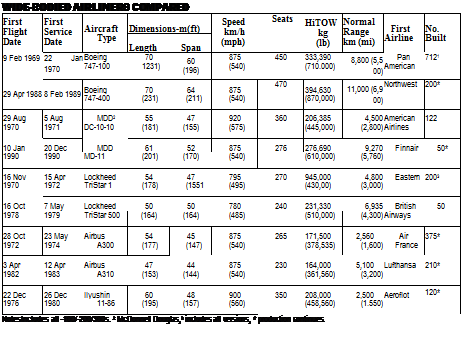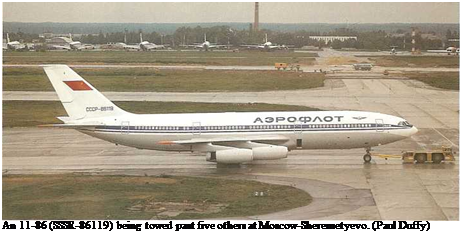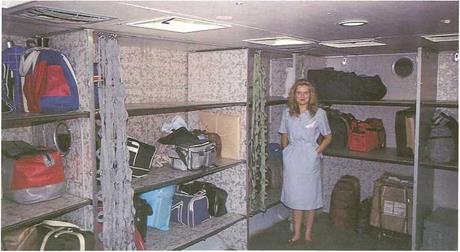The First Soviet Airbus

 |
Long Gestation
By the time the Soviet Aircraft industry got under way with its first wide-bodied airliner, the Boeing 747 had already entered service. News filtered through to the West during summer 1971 that the Ilyushin Design Bureau, with Genrikh Novozhilov taking over from Sergei Ilyushin’s design leadership, was working on a four-engined wide-bodied airliner, with podded engines on the wing. The 350-seat Ilyushin 11-86 had two aisles, permitting eight – or nine-abreast seating, and like most large Soviet aircraft, had a multiple-wheeled landing gear, 14 altogether, with main wheels mounted on three tandem-mounted pairs of four. The center one of the three was mounted in the fuselage, like the long-range Douglas DC-10’s. This was — again following Soviet design custom — intended to provide soft-field, but not necessarily short-field performance. When delivered, the 11-86 normally needed about 2,500m (8,000ft) of paved runway for airline service.
Five years elapsed before the first flight, on 22 December 1976, at Khodinka, only a few kilometers from Red Square. This was almost like a new big jet making its maiden flight
from London’s Hyde Park or New York’s Central Park — or even down Washington’s Mall. Production was at Voronezh.
The first Aeroflot scheduled Ilyushin 11-86 service was in December 1980, from Moscow to Alma Ata, capital of Kazakhstan, and the destination city of the only Soviet supersonic airline service. Right from the start, the aircraft had never been promoted as a long-range airliner and it was compared unfavorably with western wide-bodied types. But with state-supplied fuel and with no competitive pressure, this was not an issue for Aeroflot’s operational requirements.
Virtue Out of Necessity
As time went on, with most of Aeroflot’s transatlantic flights of necessity stopping at Shannon, the spirit of free enterprise and innovative minds generated opportunities for cooperation between Aer Rianta, the Irish airport authority, and Aeroflot, to their mutual advantage. Aeroflot set up its own fuel ‘farm’ and thus avoided having to pay out scarce hard currency. Aeroflot paid for airport charges with fuel, which
The 11-86’s carry-on baggage arrangements are excellent. Passengers can deposit their ‘not wanted on voyage’ items on the ‘left-luggage’ shelves.
Shannon then sold to other carriers, including, ironically, U. S. military VIP flights. Soviet travelers also liked the duty-free shopping amenities, and Aeroflot and the airport authorities in Russia invited the Irish to set up similar facilities in Moscow and Leningrad. Ilyushin Il-86s began to call at Shannon in the mid-1980s and Aeroflot became the airport’s biggest customer. In 1990, the Soviet airline began to take advantage of liberal international regulations as the airline world deregulated, and began to promote Ireland as a destination from the United States. Far from being a necessary evil, Shannon has become an Aeroflot asset.
|
|
|
ILYUSHIN IL-86 CARRY-ON BAGGAGE CONVENIENCE |
|
Standard Overhead Racks |
|
Lower Level Luggage Compartment |
|
|||
|
|
||

Made For The Market
The 11-86 had some good features, apart from substantially improved cabin and galley furnishings — even the seats were more comfortable than those that had served Aeroflot since time immemorial. The passenger entrance was through doors in the fuselage lower level up self-contained collapsible steps. Immediately on entering, passengers could take advantage of one of the airliner’s best features, and one that other manufacturers could well copy. This was a downstairs luggage compartment, where all excess carry-on baggage — and Russians always travel with excess — could be deposited, in a ‘not-needed-on-voyage’ aerial equivalent of shipping practice. Incidentally, anticipating extremes of temperature at such destinations as Yakutsk, plastic wing covers were made for the 11-86.
The critics of the Soviet aircraft industry concentrated on its wide-bodied candidate’s lack of range. It could not carry a full payload across the Atlantic, unless it stopped at Shannon and Gander — a necessity that had been dispensed with as long ago as 1957, with the introduction of the Bristol Britannia and the Douglas DC-7C. The critics should have put themselves in the shoes of the Ilyushin market researcher. Not a single intercontinental long-range route required the services of an airliner bigger than the Ilyushin I1-62M. The density of traffic on routes such as Moscow-New York, or Moscow-Tokyo did not come close to that on routes such as London – New York or Los Angeles-Tokyo, and could certainly not justify a 350-seat airliner. And Ilyushin had no illusions about the slim chances of breaking into the world market against Boeing, McDonnell Douglas, Lockheed, and Airbus.
Domestically, the requirement was quite different. Only two major cities in the far east, Khabarovsk and Vladivostok, were far enough away from the big cities of European Russian and Ukraine to demand an aircraft larger than the I1-62M. The main markets from Moscow, Leningrad, and Kiev were to the Black Sea and Caucasian resorts, and to destinations such as Novosibirsk, Tashkent, and Krasnoyarsk — within 11-86 range. Whatever the shortcomings of the Ilyushin wide-bodied airliner for long ranges, it was just right for Aeroflot.

 One of the best features of the 11-86 is the lower level baggage compartment, where passengers can stow carry-on items that are not needed during the journey. (R. E.G. Davies)
One of the best features of the 11-86 is the lower level baggage compartment, where passengers can stow carry-on items that are not needed during the journey. (R. E.G. Davies)











